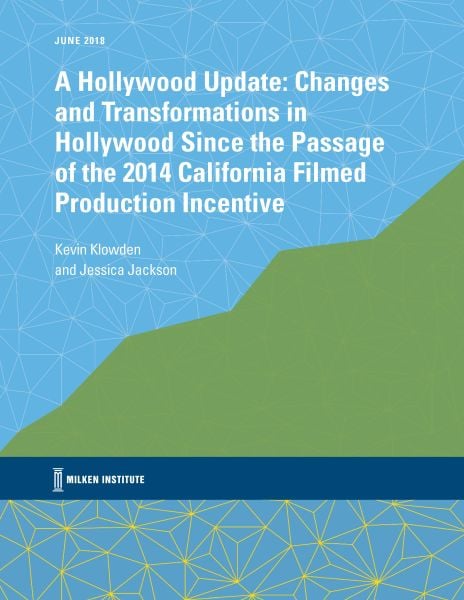
A Hollywood Update: Changes and Transformations in Hollywood Since the Passage of the 2014 California Filmed Production Incentive
Since the passage of the expansion of California’s Film and Television Production Credit in 2014, the global competition for attracting movie and television production has continued to heat up. California’s film credit has demonstrated the fact that the state’s comparative advantages as a globally recognized center of filmed production gives it an inherent advantage in attracting and retaining both productions and employees.
Since the publication of the 2014 Milken Institute report “A Hollywood Exit,” California’s filmed entertainment industry has continued to stay competitive, but the most significant rivals still remain and, in some cases, have become stronger. As the data in this report on Hollywood changes demonstrates, the 2014 expansion of the filmed production credit has been highly successful, not only in significantly increasing filming days, but also for impacting the state’s entertainment production employment.
The findings and recommendations of this report on Hollywood changes are intended to function as an update and supplement to the 2014 “A Hollywood Exit” report.
Conclusions:
- Competition has increasingly shifted to locations that are considered to have more flexible and uncapped (or very high) incentives, which show stability
- The current structure of the $330 million incentive is hitting its limit, particularly for movies.
- The current mandate that 75 percent of a movie production be spent in the state is clearly inhibiting California’s ability to attract and retain larger budget movies.
- Even under the revised incentive format, long-running television shows run the risk of blocking newer productions from receiving the production credit.
- Diversity has proven incredibly important in the entertainment industry—but efforts to legislate a solution have proven difficult.
- Diversity clearly paid off at the box office in 2017 and so far in 2018.
Recommendations for California:
- Increase the level of the current incentive to a higher number—ideally matching or exceeding New York’s $420 million per year.
- Devote a significant portion of the new money to larger budget movies and independents.
- Adjust the amount of spend a movie production needs to have in California to qualify, particularly for movies with budgets over $100 million
- Develop a structure for gradually reducing the amount of credit available to ongoing television productions in order to ensure funds are available for new television productions as well as existing ones.
- Develop a strategy for boosting women and minority employment, in collaboration with Hollywood, that factors in a strategy for women and minority participation as part of the bid process.


